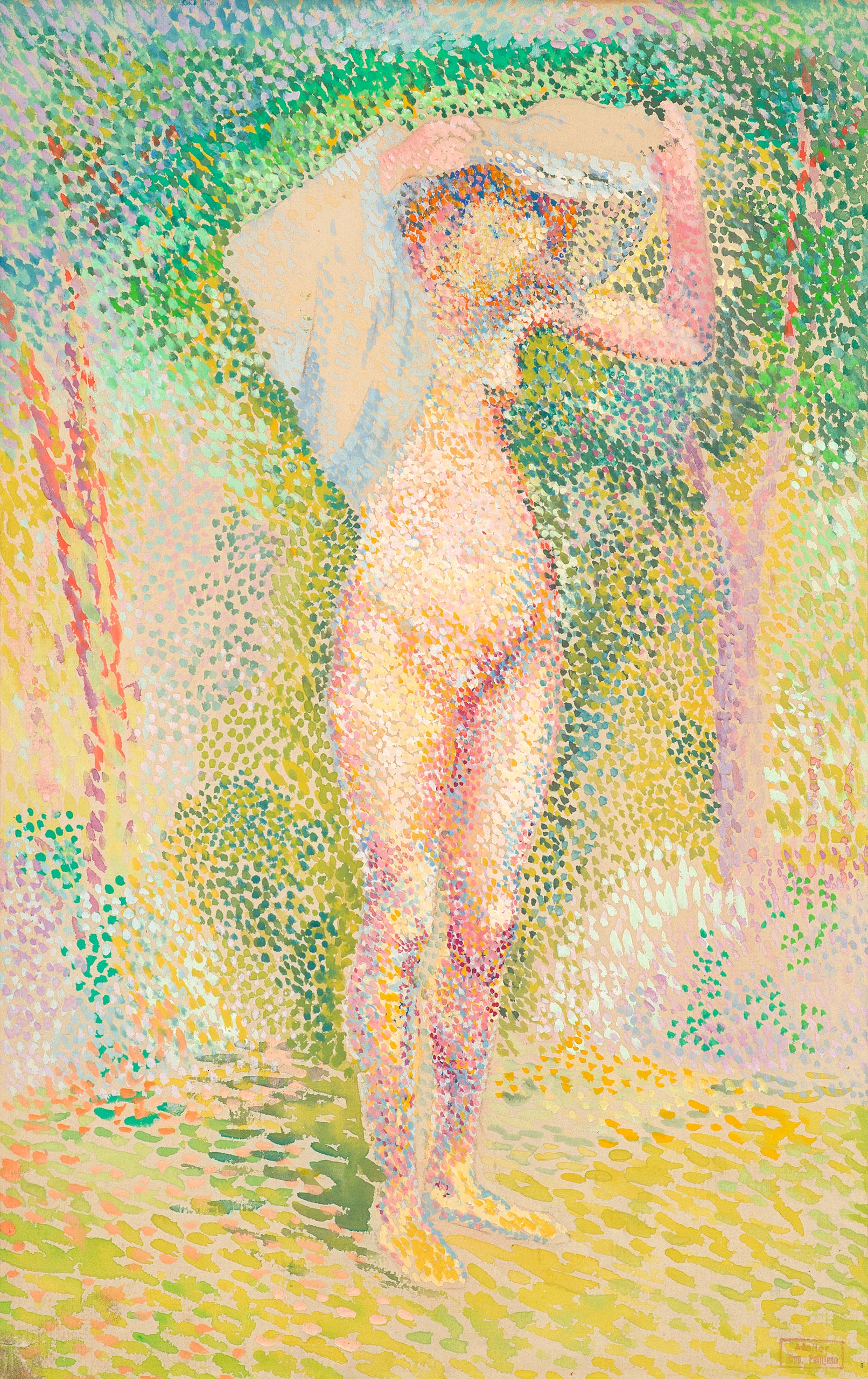
Petitjean
Hippolyte
Mâcon 1854 — Paris 1929
Young Woman Taking off her Dress
Watercolour on paper.
390 x 240 mm (15 6/16 x 9 7/16 in.)
Provenance
The artist’s studio, his stamp lower right (Lugt 2022c).
This elegant, luminous pointillist drawing is one of the most attractive works on paper by Mâcon painter Hippolyte Petitjean. Born into a very modest social background, Petitjean worked for a decorative painter from an early age. In 1872, he moved to Paris, where he studied at the Arts décoratifs and the École des Beaux-Arts under Alexandre Cabanel. The art of Pierre Puvis de Chavannes made a lasting impression on him throughout his career. After meeting Georges Seurat in 1884, he embraced pointillism and divisionism. The testimony of their friendship survives in a portrait of Petitjean drawn by Seurat. In 1891, he exhibited at the Salon des Indépendants, then took part in the Divisionist exhibition at the Le Barc de Boutteville art gallery in 1892, an avant-garde gallery set up at 47 rue Le Peletier and open to Impressionist and Symbolist artists between 1891 and 1897. He also exhibited in Brussels at the Salons of the group of the XX in 1893, and of the Libre esthétique in 1898. Along with Théo Van Rysselberghe and Henry van de Velde, he was one of the artists who helped spread and establish Divisionism in Belgium. From 1893, he was represented by Lucien Moline’s gallery on rue Laffitte, which specialized in Neo-Impressionists.
Close to libertarian and anarchist circles, but not fully committed to them, Petitjean also produced illustrations for Les Temps nouveaux under the name Jehannet, including L’Aube in 1896. His portrait of Marthe Charles-Albert testifies to his closeness to the champions of social art. He contributed to Hommage des artistes à Picquart, published in 1899 to show support for Colonel Picquart, who had been imprisoned for six months for defending the innocence of Albert Dreyfus. In 1894, he quarreled with Signac, finding the Divisionist system too confining, and expressed his admiration for the Impressionists, especially Monet. He did not, however, abandon Pointillism and Divisionism, which persisted in his work until the end of his career. His graphic work shows his attachment to the observation of nature and classical drawing, although he also produced numerous pointillist watercolors. Petitjean’s career fluctuated, and a job as a drawing teacher awarded by the city of Paris helped him to support his family.
Alongside landscapes and portraits, elegiac scenes make up the majority of his work. Like Georges Seurat, they bear witness to Petitjean’s lifelong admiration for Puvis de Chavannes. The female figure depicted here, with its simple, almost geometric pose, its round yet graceful silhouette with its fine ties and slender limbs, is reminiscent of the many silhouettes that populate the Lyon master’s murals: these include the seated woman removing her drapery in L’Été (Summer) in the Cleveland Museum of Art, dating from 1891, or the hieratic, lanky silhouettes in Bois sacré cher aux arts et aux muses (Sacred wood dear to Arts and Muses) in the staircase of Lyon’s Musée des Beaux-Arts, 1884.
This type of subject also testifies to the political ideal he shared with most Neo-Impressionists: with their reference to a golden age in which man would live reconciled with nature, without possession, these representations integrate anarchist and Proudhonian theses. The nude or draped woman in the woods is a subject close to the artist’s heart, a subject he borrows from his former master Puvis and treats in the Seurat manner whose technique is precisely applied here: pure color patches combined in dots or strokes to suggest other colors. Numerous studies on canvas of bathers, female nudes lying or standing by a tree, combing their hair or sleeping, were produced between 1895 and 1910 or even later, which makes this work difficult to date.
- Exhibited at the Exposition centenaire in 1955, then property of the artist’s daughter.

